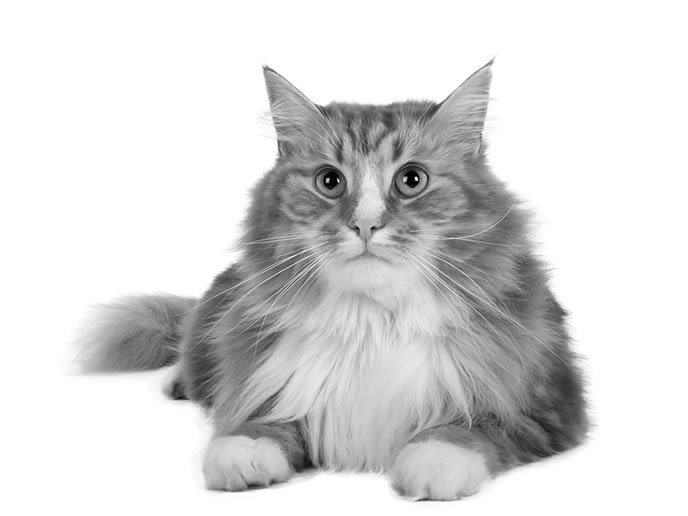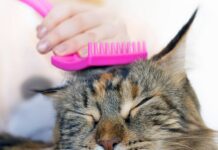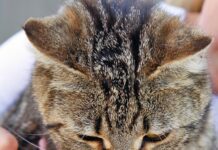If clouds of cat hair don’t complement you, your furniture or your home, you may be among the owners looking for solutions to shedding. Dermatologist William H. Miller, VMD, Medical Director of the Cornell University Companion Animal Hospital, has a simple two-step prescription to tame it: a brush and a vacuum.
Shedding is a normal function. However, Dr. Miller offers this cautionary advice: If your cat’s shedding appears to be unusually heavy or results in bald spots, make a veterinary appointment to determine if he has an underlying medical condition. High fevers, allergies, the hormonal imbalance hyperthyroidism, pregnancy and parasites like fleas and ticks can cause a cat to shed excessively.

BigStock
If your cat doesn’t have a health-related problem, Dr. Miller offers an explanation of hair growth to help you understand and cope with shedding. Hair growth in nearly all species occurs in cycles throughout the year:
In the active anagen phase, the hair is hard to pull out, or epilate.
In the telogen phase, hair stops growing and remains in the hair follicle. “It can be epilated easily with fingers, combs, brushes, etc.,” Dr. Miller says.
In the photoperiod, or light cycle, the length of daylight triggers changes in shedding. Cats generally will not lose hair in the heat of summer, as you might expect. Instead, they’ll shed in the fall to accommodate thicker hair for winter. They’ll shed that thick hair in the spring.
The season can be a clue if you’re worried that your cat’s shedding is abnormal. If a cat living in the North undergoes a major shed in the summer or the dead of winter, he has a problem, Dr. Miller says. “Obviously, the influences for shedding are different in the Northeast than they are in Florida. In warm weather, the cat doesn’t want a thick dense coat, whereas that type of coat is desirable in cold weather.”
The challenge of some indoor cats is that they can shed year-round. The many factors that influence it include the type of lighting in the house, the intensity and duration of the ambient light outside the house, and whether the owner is a night owl and stays up late into the early morning hours, Dr. Miller says.
Other factors can influence shedding in general:
Lower the Anxiety Level
Hyper-excitable animals tend to shed more than placid ones, Dr. Miller says. During the stress of a veterinary visit, telogen hairs that aren’t anchored into the hair follicle may begin to fall out. “Think of the cat with a beautiful coat who all of a sudden starts to shed when he walks into the veterinarian’s office,” Dr. Miller says. (See “Why Cats Hate Veterinary Visits” in the June issue of CatWatch for solutions to easing the stress of clinic visits.)
Anxious cats don’t get goose bumps like we do when we experience a chill or a sudden scare, but a cat’s hair follicles can straighten in a process known as piloerection. It’s an erection of the hair due to contraction of the tiny muscles that elevate the hair follicles. A similar process helps form goose bumps in humans. Piloerection loosens the telogen hairs, and some fall out.
Feed a High-quality Diet
Hair is made from the protein keratin. Cats who don’t get adequate animal protein in their diet may experience unusual shedding. Excessive fat in the diet can also cause shedding, but — to confuse things — omega-3 and omega-6 fatty acids are important for healthy skin and coat. It’s best to consult your cat’s veterinarian or ask for a referral to a veterinary nutritionist for help in creating a balanced diet.
The Effect of Genetics
Short-haired breeds such as Sphynx, Tonkinese, Burmese, Cornish Rex, Devon Rex, Peterbald and Siamese are among breeds who tend to shed the least. On the other hand, the Himalayan, Persian, Siberian and Maine Coon shed a great deal. Piloerection is self-perpetuating in these high-shed cats. When the hair follicle is empty, the hair bulb receives a signal to start growing hair, so a very highly nervous cat is constantly supplied with new hair to shed.
Despite popular belief, non-shedding cats don’t exist, Dr. Miller says. Some breeds do have a different hair cycle than other breeds, so shedding may not be as obvious, but it still does occur. If these “non-shedding breeds” truly didn’t shed, they would grow their coats continually and their hair would drag on the floor, Dr. Miller says.
One final factor in hair growth is a process described as asynchronous growth, meaning hairs don’t all grow at the same time. Some hairs actively grow, while adjacent ones are in the no-growth telogen phase. This may seem an odd act of nature, but Dr. Miller says it’s fortuitous. “If all hairs were in the same phase of growth, the dog or cat would go totally bald when he sheds. That would make house cleaning easier, but bald dogs and cats really aren’t beautiful.”



